Pierre-Auguste Renoir (Limoges, 1841 - Cagnes-sur-Mer, 1919) is one of the most important painters of Impressionism. Known primarily for his art marked by a strong joie de viv re (“joy of living”) and his aigre phase (i.e., inspired by the painting of Ingres), he is now considered one of the most important French artists. His major works include: La Grenouillère (1869), Dancing at the Moulin de la Galette (1876), The Rowers’ Breakfast (1880-1882), On the Terrace (1881),The Umbrellas (1881-1886) or The Large Bathers (1884-87). Through his trip to Italy in 1882, the artist discovered and studied artists such as Donatello or Raphael who influenced and inspired his new way of painting.
Impressionism is an artistic movement that spread in the mid-19th century, between 1860 and 1870, in Paris. The term “Impressionism” comes from the negative meaning given to the movement by Louis Leroy, a journalist and art critic, after seeing the first exhibition of the Impressionists in 1874. The main innovation the Impressionists brought was painting en plein air, or in the open air. Among the movement’s most important painters, besides Renoir, are Claude Monet, Édouard Manet, Edgar Degas, and Camille Pissarro. Although part of a movement that had common foundations, these painters adopted completely different styles and themes.The main distinguishing feature of the movement is the same approach to the use of light and color. Through color, given by pure tube colors in quick, dense brushstrokes, the Impressionists succeeded in representing reality by capturing instantaneous impression.
To this day, many of the artist’s character and aesthetic aspects are recounted by his son Jean Renoir in the book Renoir my father (Garzanti, 1962). The son describes his father this way: “My father had something of an old Arab and much of a French peasant, with the difference that his skin, always protected from the sun by the need to keep the canvas out of deceiving glare, had remained as clear as that of a teenager. What struck the strangers who met with him for the first time were his eyes and hands [...]. As for the expression of his gaze, imagine a mixture of irony and tenderness, of mockery and voluptuousness. It seemed as if his eyes were always laughing, that they first of all glimpsed the funny side of things; but it was an affectionate, good smile. Or perhaps it was a mask; for he was extremely demure and did not want his neighbor to notice the emotion, equal to that which other men feel in touching or caressing, that assailed him at the mere sight of flowers, women or clouds in the sky. His hands were frighteningly deformed; rheumatism had caused the joints to give way, folding the thumb toward the palm and the other fingers toward the wrist. Visitors unaccustomed to that mutilation could not tear their eyes away from it; the reaction and thought they dared not formulate was this: ’It is not possible. With such hands he cannot paint these pictures; there is a mystery underneath!’”
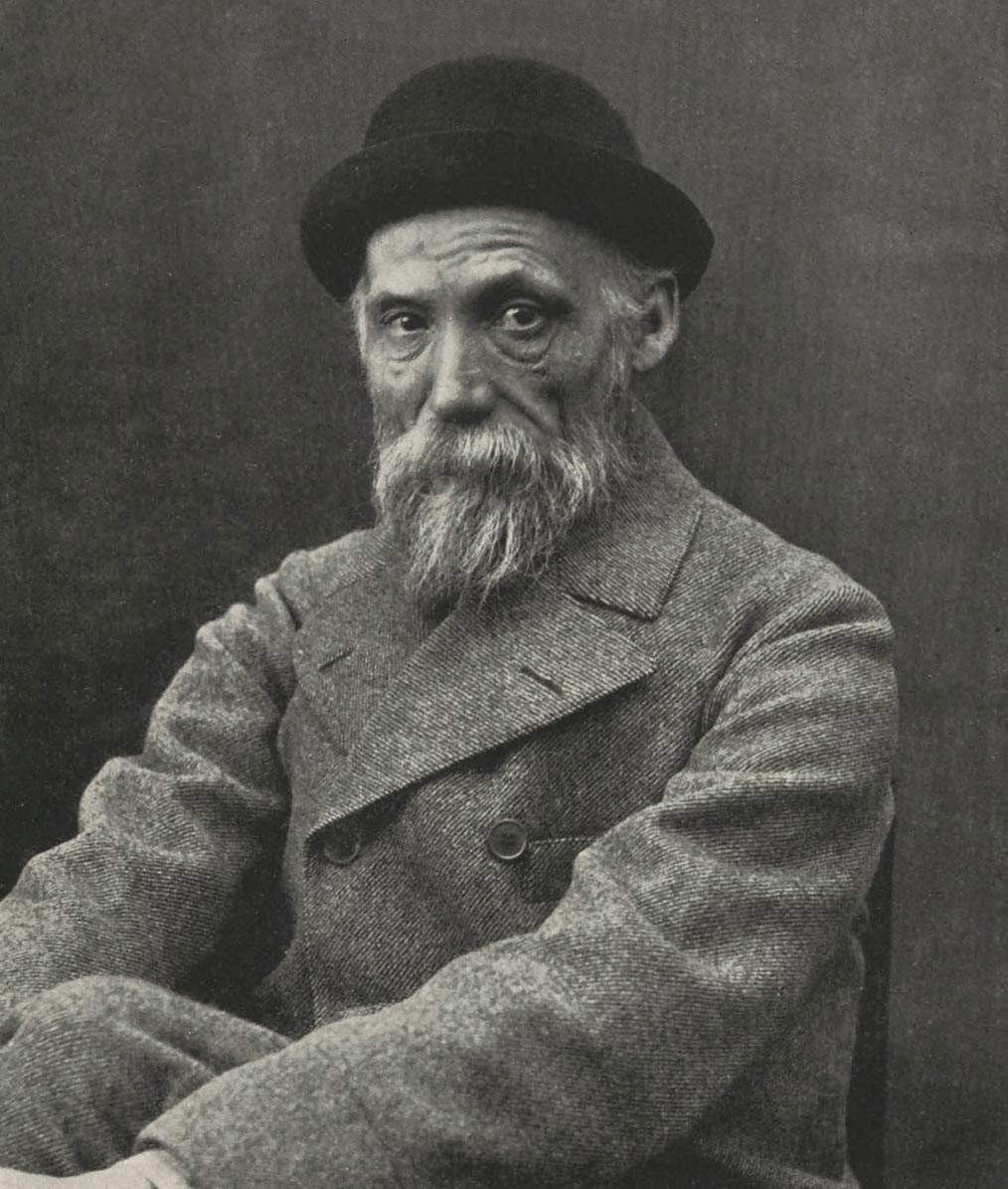 |
| Pierre-Auguste Renoir photographed by Paul Durand-Ruel |
Pierre-Auguste Renoir was born in Limoges on February 25, 1841, to a family of modest origins, his father a tailor and his mother a textile worker. He spent his childhood in Paris where he attended elementary school at the Brothers of the Christian Schools, revealing an incredible talent for drawing as well as singing. This passion of his is mainly indulged by his father, who spends his little savings to buy useful drawing materials. In 1854, Renoir joined a porcelain manufactory, a typical activity in his hometown. The firm shortly thereafter, in 1858, declared bankruptcy and the artist found himself without a job, so he decided to strike out on his own and help his engraver brother. Renoir began attending courses at theÉcole de Dessin et d’Arts décoratifs, which made the desire to become a painter grow in him. In 1862 he enrolled at the École des Beaux-Arts and at the same time collaborated with the painter Marc Gabriel Gleyre, with whom, however, he did not share the same approach to painting. It was during these years that he met Claude Monet, Alfred Sisley, and Fréderic Bazille. The common element between them is surely the same feeling of repulsion toward ateliers and toward classical academic technique. It is from this friendship and rejection for ateliers that the desire to paint en plein air, following the example of Charles-François Daubigny, was born in them. The group of artists consisting of Renoir, Monet, Sisley and Camille Pissarro went to live in a house in the country where Renoir produced numerous works such as Lisa with Umbrella (1867), in which he portrayed his faithful friend Lise Tréhot. Later, plagued by a very severe and burdensome economic situation, he finds refuge in the rue Visconti atelier of Bazille, his close friend. Another solid and important friendship was the one he formed with Monet, with whom he painted together several times, as in the case of the 1869 work La Grenouillère painted in his company.
With the advent of the Franco-Prussian War in 1870, he was called to enlist, thus abandoning painting for a time. Following the surrender of Sedan, in the same year he returned to Paris where he resumed his activity by moving back to the rive gauche. With his return home his economic situation worsens; his psychological situation is also unstable given the death of his close friend Bazille during the war. Despite the difficulties, Renoir continued to paint, coming closer and closer together with Monet to what is now recognized as Impressionism.nWith his membership in the Société anonyme des artistes peintres, sculpteurs, graveurs , a society created by Pissarro to raise funds for the organization of exhibitions, the artist formalized his entry into the Impressionist group. Thanks to the income earned from the association, they put on their first exhibition on April 15, 1874, in the studio of photographer Nadar at 35 boulevard des Capucines. It was on this occasion that critic Louis Leroy gave the group the famous appellation "Impressionists," which perfectly describes their intent to capture the moment.
Critics are divided into those who admire the new style of painting and those who do not. Renoir is almost always described as a gifted painter, but despite this he almost never manages to sell his paintings, thus worsening his economic situation. To earn money he decides to organize together with the merchant Paul Durand Ruel and Berthe Morisot, an Impressionist painter, an auction at the Hôtel Drouot. Here, too, the painter fails to sell what he would like, and is forced to sell off works in order to scrape together some money. Fortunately, the auction is also attended by Victor Chocquet, a customs official, who, looking at Renoir’s paintings, becomes passionate about them and decides to support him financially, commissioning eleven paintings from him. With the money he earned he bought a house in Montmartre, thus beginning his economic ascent. He became known throughout Paris for his portraits, and his works began to hang in the most important bourgeois salons. In addition to portrait painting he remained associated with en plein air painting and in 1876 painted Bal au moulin de la Galette, one of his best-known and most popular paintings.
By the end of the 1870s the Impressionist group gradually split, and the painter was accused by his peers of selling out his paintings only for fame and money. With the movement’s breakup, a desire to travel grew in him: so he visited Algiers in 1880 and Italy in 1882. In Italy he studied the Renaissance masters, being strongly influenced by Raphael Sanzio and Jean-Auguste-Dominique Ingres, and his painting style from this point on changed and the aigre or ingresque period was inaugurated, as influenced by Ingres. Beginning in Venice he began his tour to descend slowly to the south, visiting cities such as Padua, Florence, Rome, Urbino and Naples, arriving as far as Palermo. Following his visit to our country he declares, “The Italians have no merit in having created great works in painting. It was enough for them to look around. Italian streets are full of pagan gods and biblical characters. Every woman nursing a child is a Madonna by Raphael.”
By the last period of his life his fame was established and he was regarded as one of the most important painters of France and Europe. In 1905 the French state, out of gratitude, decides to award him the Legion of Honor. With advancing age he was struck by rheumatoid arthritis, which paralyzed his legs. The course of his illness is spent at his new seaside home in southern France, Cagnes-sur-mer. There he died on December 3, 1919.
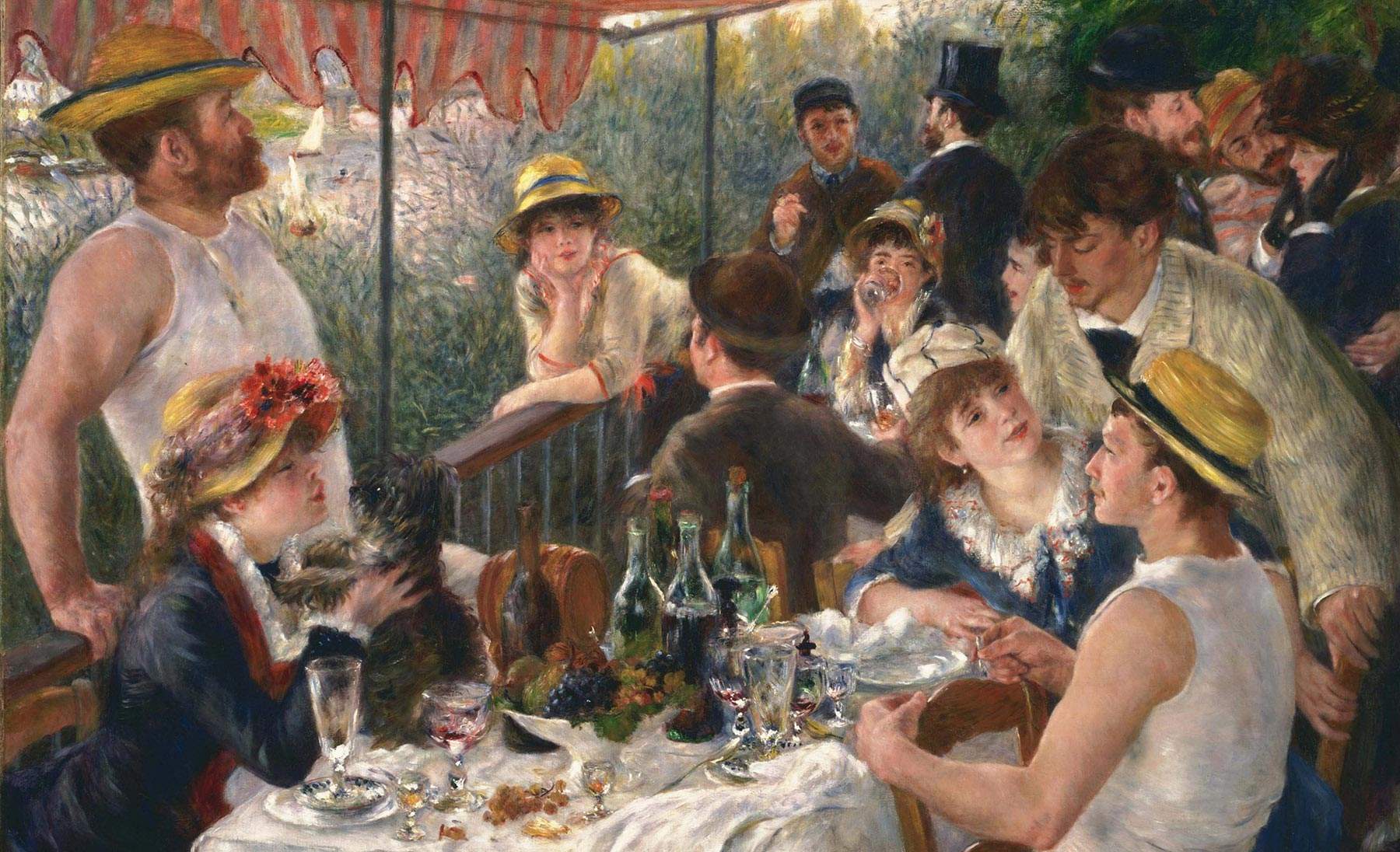 |
| Pierre-Auguste Renoir, The Rowers’ Breakfast (1880-1881; oil on canvas, 130 x 173 cm; Washington, Philips Collection) |
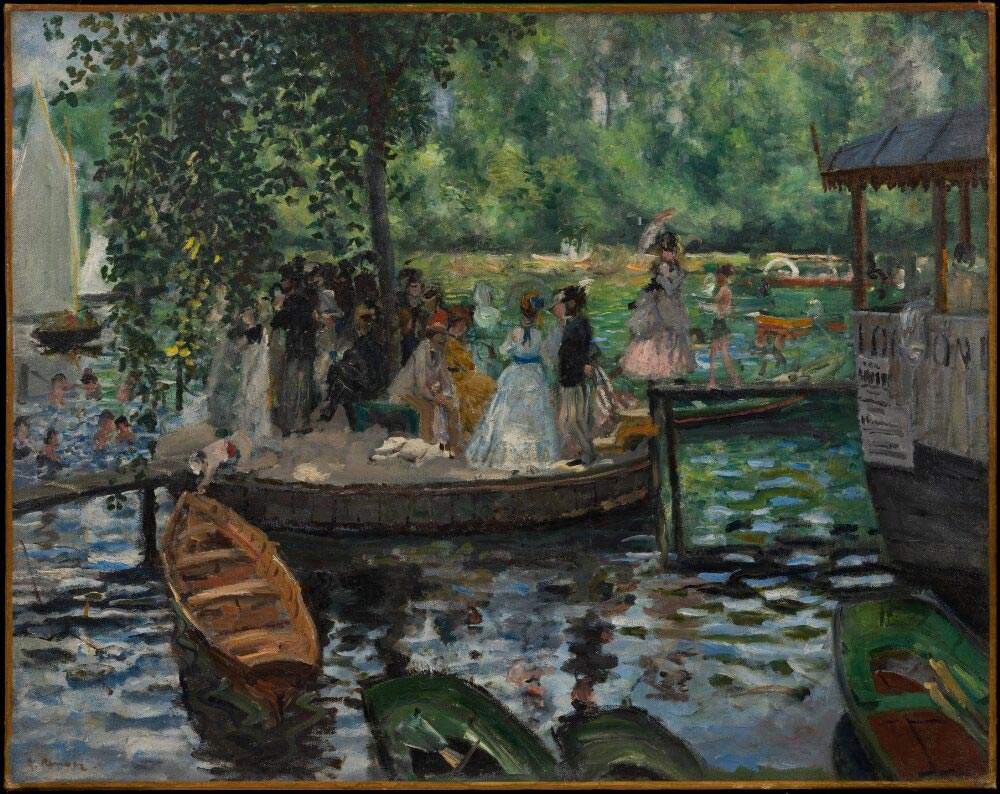 |
| Pierre-Auguste Renoir, La Grenouillère (1869; oil on canvas, 66 x 81 cm; Nationalmuseum, Stockholm) |
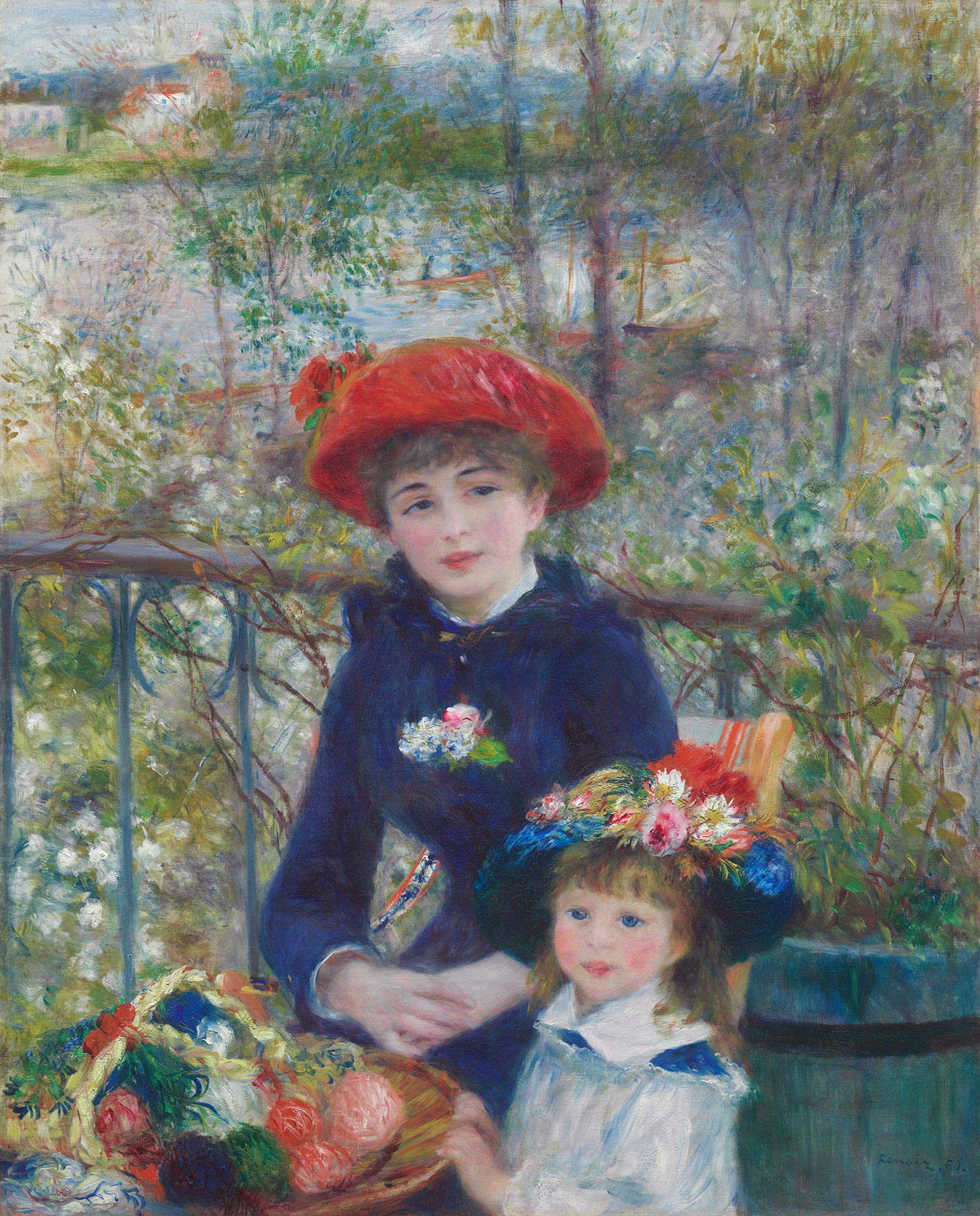 |
| Pierre-Auguste Renoir, On the Terrace (1881; oil on canvas, 100 x 80 cm; Chicago, The Art Institute) |
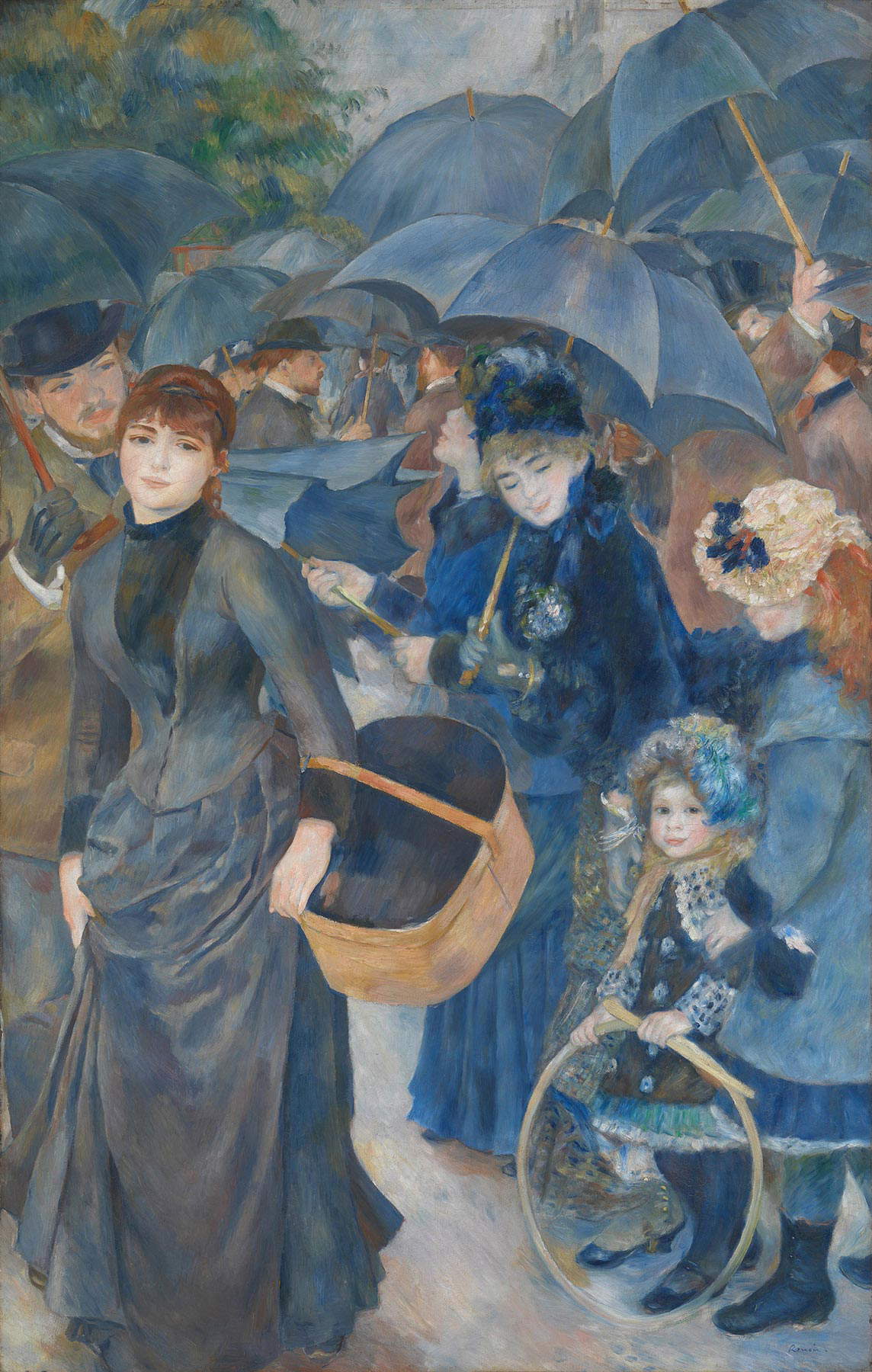 |
| Pierre-Auguste Renoir, The Umbrellas (1881-1886; oil on canvas, 180 x 115 cm; London, National Gallery) |
Renoir took part in the Impressionist group, later becoming a major exponent. His artistic activity is very prolific: in fact, the artist can boast a total of about five thousand paintings not counting watercolors and drawings. During his artistic career he developed different themes that touched different periods of his life. He began his artistic career working for a porcelain factory, dreaming of being a porcelain maker, a typical trade in his home country. Over time, however, the desire and passion for painting grew in him, leading him to enroll at theÉcole des Beaux-Arts in Paris and work at the atelier of Marc Gabriel Gleyre. After several attempts, the artist achieved success thanks to Victor Chocquet who commissioned works from him while supporting him financially.
His painting is an art of “joie de vivre,” or the joy of living. This meaning is given his positive attitude toward life, which he also pours into his paintings where he illustrates all the beauty and sweetness of the world and life. This positivity is also conveyed in the paintings through his skillful use of colors, using bright and vivid hues. In this early pictorial period, his paintings are characterized by extreme brightness and the use of vivid colors thatare spread on the canvas through delicate brushwork, giving the works a vibrant and delicate tone. His subjects are also serene and usually depicted dancing or passing the time carefree during scenes of everyday activities. One of the best known paintings from this period is Le Bal au Moulin de la Galette from 1876 in which Renoir illustrates, with the characteristics described above, an outdoor scene where the painting’s protagonists are intent on dancing. The scene is set at the Moulin de la Galette, an establishment frequented by people from all walks of life. In the foreground is a table of friends laughing and joking, their faces as graceful and carefree as those of the crowd behind. A few years later he painted The Rowers’ Breakfast (1880-1881), which is considered one of the last paintings of the early “joie de vivre” period. Again the artist depicts a series of characters, probably rowers with their wives, around tables in a diner as they enjoy the beauty and serenity of life. As usual, the graceful atmosphere is provided by the delicacy of the brushwork and the accentuation of vivid colors and.
As anticipated, thanks to his study of Renaissance painters Renoir discovered the figure of Raphael and was extremely fascinated by him. This phase of change is known as the “aigre” period: it is a time when, the artist detaching himself from Impressionism, he arrives at a more penetrating and incisive painting, employing a cleaner and less graceful drawing. From plein air he returns to atelier painting, depicting mainly classical subjects such as figures of nude women or portraits of various kinds. The Umbrellas (1881-1886) is a painting made between the painter’s two phases, and the different characteristics of each period can be seen in this painting. The right side is painted at an early stage, during his first period, which is related to a more Impressionist style. The left part, on the other hand, is the most recent, painted right in the aigre period, in which a return to classicism can be seen. The subject of the painting, as is often the case, is a crowd trying to shelter under their umbrellas after a sudden thunderstorm. The two main figures in the image are the woman on the left and the little girl holding the circle on the right, which as anticipated each represents a different stylistic period.
The Bathers (1884-1887) is another famous painting because it denotes the artist’s stylistic shift. Whereas in previously analyzed paintings (as in Le Bal au Moulin de la Galette or The Rowers’ Breakfast) the subjects are depicted with graceful strokes and vibrant brushstrokes, here they are represented in a sharper and more coincidental manner. Portrayed are three undressed women in the foreground intent on bathing in water, the contours of the figures sharp and precise influenced by a classical manner. The theme of the bathers is also taken up again late in the 1918 painting of the same name, and is one of the painter’s last paintings. Here, two women who are always naked in the midst of nature are depicted, and compared to the previous painting the brushstrokes are less refined thanks in part to the frottage technique (a painting technique given by the rubbing of color on the canvas). Renoir in this painting thus returns to using a greater thickness of lines while rejecting slenderness and cleanliness. The colors he uses are also different; in this case they return to being more garish and vivid as in the first period. Similar to the works of the earlier period, the artist returns to depicting freshness and enjoyment of life.
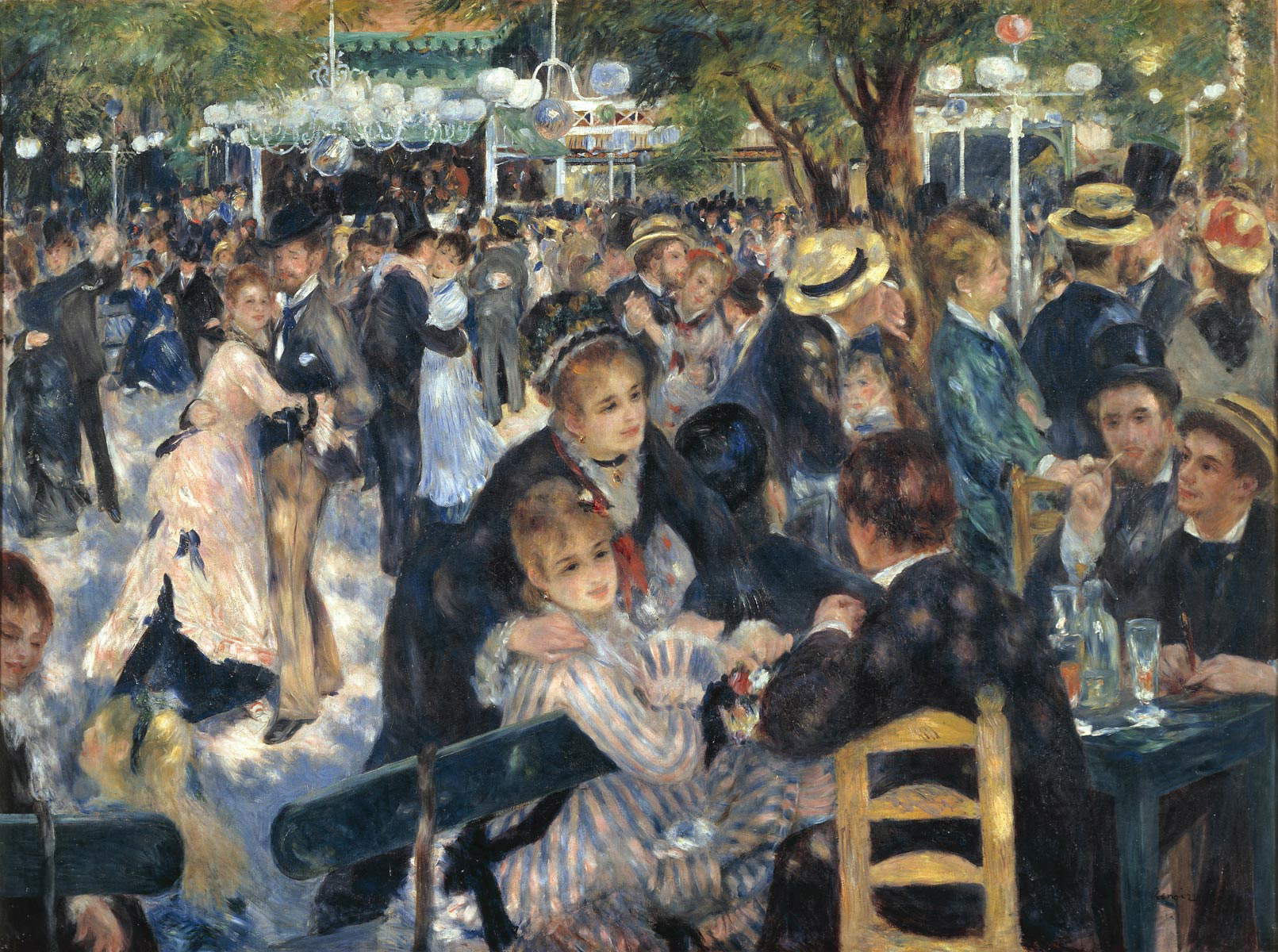 |
| Pierre-Auguste Renoir, Bal au moulin de la Galette (1876, oil on canvas, 131 x 175 cm; Paris, Musée d’Orsay) |
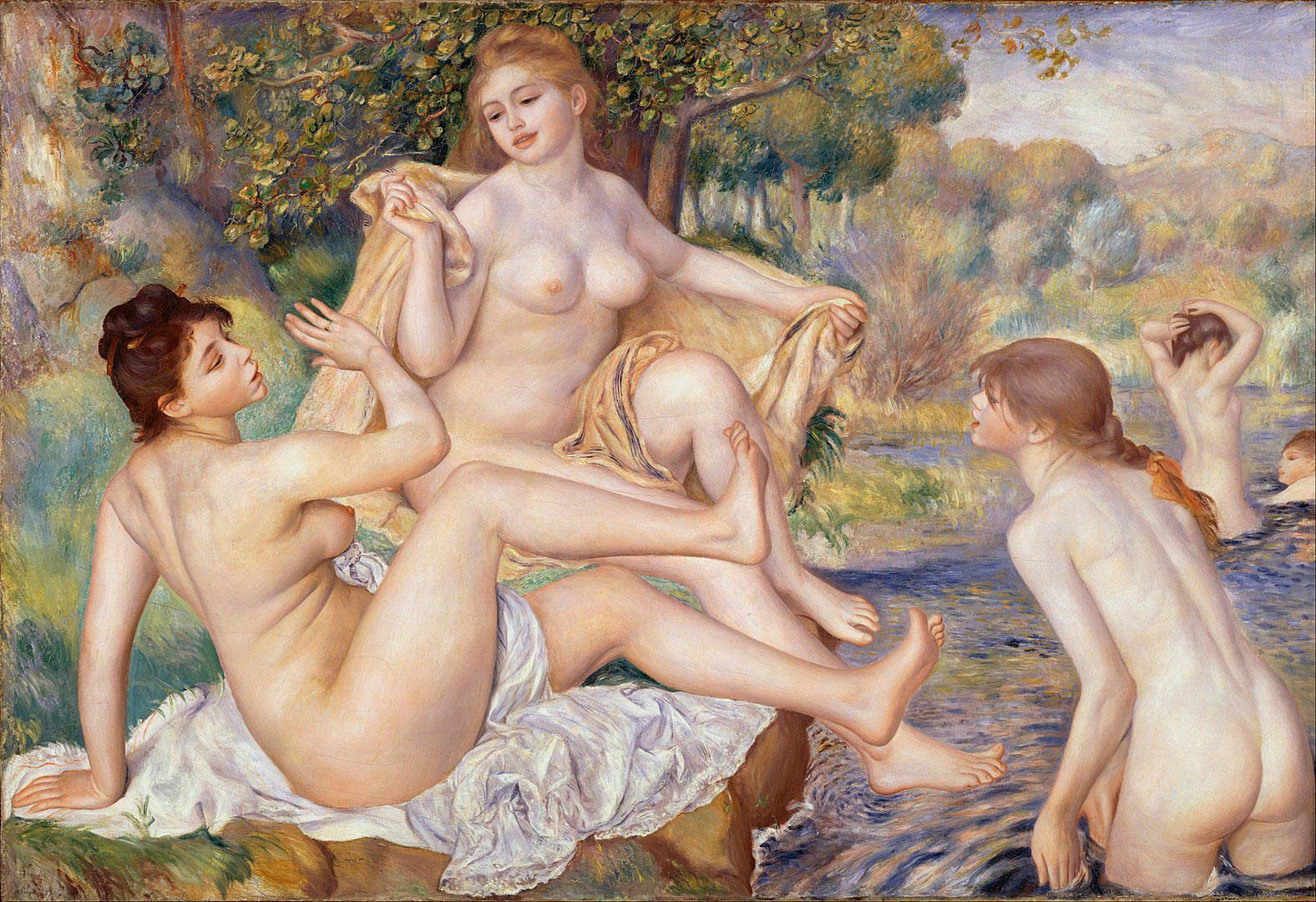 |
| Pierre-Auguste Renoir, The Bathers (1884-1887, oil on canvas, 117.8 x 170.8 cm; Philadelphia, Philadelphia Museum of Art) |
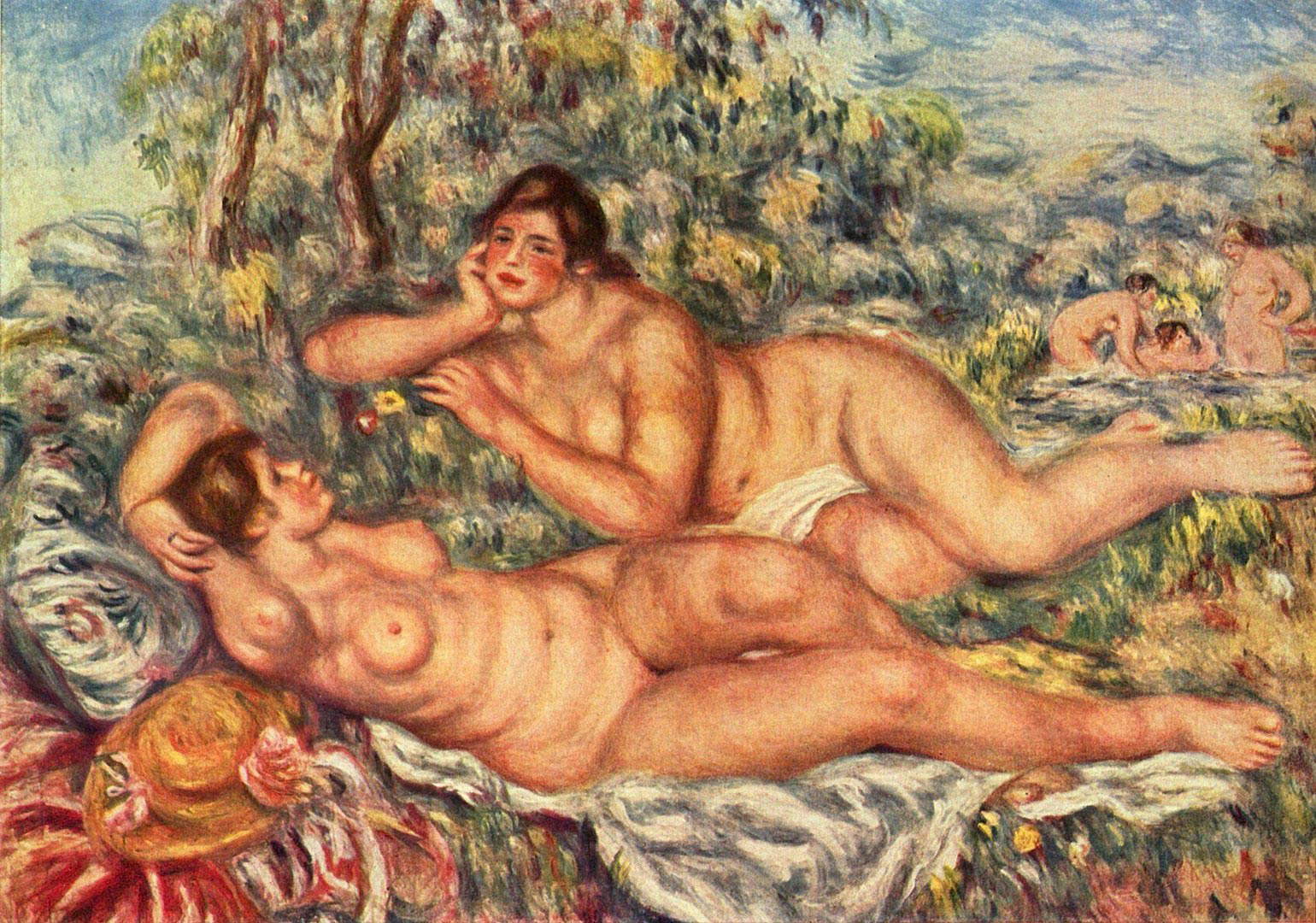 |
| Pierre-Auguste Renoir, The Bathers (1819; oil on canvas, 110 x 160 cm; Paris, Musée d’Orsay) |
Renoir’s villa in Cagnes-sur-mer on the French Riviera, his last home, now houses a house-museum in his memory. Inside are fifteen original canvases, forty sculptures and all the authentic furniture. Next to the house it is also possible to visit his studio in the garden, a faithful reproduction of his old studio.
Also in France, two very important institutions, the Musée d’Orsay and the Musée de l’Orangerie, house the world’s largest and most comprehensive collections of the artist. Other works are housed at such distinguished institutions as the Museu de Arte in São Paulo, the National Gallery of Art in Washington, the Rijksmuseum in Amsterdam, the Getty Museum in Los Angeles, or the Alte Nationalgalerie in Berlin.
 |
| Pierre-Auguste Renoir, life and works of the impressionist of joie de vivre |
Warning: the translation into English of the original Italian article was created using automatic tools. We undertake to review all articles, but we do not guarantee the total absence of inaccuracies in the translation due to the program. You can find the original by clicking on the ITA button. If you find any mistake,please contact us.